 . We have the device produce an electron in this
particular state and then measure the electron's position. Of course, we get
different answers every time we use the device: position would be
a "random variable". This file
contains the results of 1000 position measurements. (I've sorted the
position measurements: from highest to lowest-- repeated measurements
of position would produce patternless results.) Your job is to
plot the probability density as a function of position. A complete
answer would include estimates of the probability density
(with error!) at various positions.
. We have the device produce an electron in this
particular state and then measure the electron's position. Of course, we get
different answers every time we use the device: position would be
a "random variable". This file
contains the results of 1000 position measurements. (I've sorted the
position measurements: from highest to lowest-- repeated measurements
of position would produce patternless results.) Your job is to
plot the probability density as a function of position. A complete
answer would include estimates of the probability density
(with error!) at various positions.
 /e and
/e and
 /l).
/l).
- Show that classical equation of motion:
z(t)=z0-½gt2
becomes:
z'(t')=z'0-t'2
in our dimensionless variables.
- Using the data on p.6 show that this is in fact how the expectation value of position is moving.
- Show that the dimensionless variables behave as if m=½ in that for example, if the dimensionless momentum p'=1, the dimensionless velocity (length/time) v'=2 and the dimensionless kinetic energy is 2.

Find  z' and
z' and  p'
for the eigenfunctions: n=1,2,4,8,16. (Hint: the p' operator is
just -i × the derivative w.r.t. z'; of course it's hermitian).
Plot the uncertainty product
vs n. What seems to be the relationship between the two.
Explain.
p'
for the eigenfunctions: n=1,2,4,8,16. (Hint: the p' operator is
just -i × the derivative w.r.t. z'; of course it's hermitian).
Plot the uncertainty product
vs n. What seems to be the relationship between the two.
Explain.
The easiest solution for Schrödinger's equation
(see example ½) is the
constant potential: V(z')=V0. If
E<V0, we still have a turning point at
z=0, i.e., the ball will still bounce up from the floor. Of course,
it will "tunnel" a bit into the classically disallowed region of
z<0; in fact the solution to Schrödinger's equation
is just an exponential:  =exp(
=exp( z')
where
z')
where  =(V0-E')½.
Matching the wavefunctions at z'=0 amounts to equating
the "logarithmic derivative" of the wavefunction:
=(V0-E')½.
Matching the wavefunctions at z'=0 amounts to equating
the "logarithmic derivative" of the wavefunction:
 at z'=0-
to the same at z'=0+, i.e.,
at z'=0-
to the same at z'=0+, i.e.,

The below displays the resulting energy shifts if V0=10 (black energy levels are for infinite potential, red for finite [10] potential).
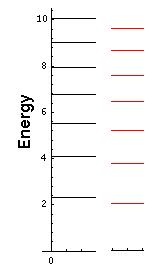
Pick some value for V0 and calculate the the energy levels for that modified potential.
 at z'=0-
to the same at z'=0+, i.e.,
at z'=0-
to the same at z'=0+, i.e.,

where x is E/eR. In the particular case that the force on the left is 27 times the force on the right: lL=lR/3 and eL=9eR. The resulting energy levels are displayed in red below (black is the usual infinite potential case).
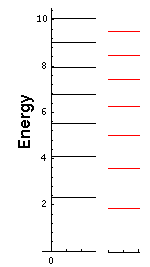
Pick some value for the left-side force and calculate the the energy levels for that modified potential.
 =0 at z=0, and hence are identical
(on the rhs) to our usual infinite-potential solutions. The latter are solutions
have even symmetry. The even and odd solutions alternate with
the even ground state at E'=1.019.
=0 at z=0, and hence are identical
(on the rhs) to our usual infinite-potential solutions. The latter are solutions
have even symmetry. The even and odd solutions alternate with
the even ground state at E'=1.019.
Make a stacked wavefunction plot of the first 5 energy eigenfunctions for this symmetric two-force problem (i.e., with V=|z'|). Be sure to include the plot of potential energy on this same plot.
- Why is it N+¾ rather than N+½?
- The falling QM ball is based on a energy eigenfunction with E' near 122.2. Find more significant digits for the energy and determine what n has this energy.
- In the case of the 27× lhs force, the energy of the 10th state is about: 12.2842. What would WKB predict (i.e., do WKB for two-sided linear case)?
- Find the WKB approximation for the energy in the symmetric two-force situation.
- Confirm the reported results for f(z')=z' exp(-az').
- Find the RR estimate for the groundstate energy using f(z')=z' exp(-az'2).
- Find the RR estimate for the groundstate energy using f(z')=z' exp(-az'3/2).
- Pick your own f(z').
- Plot the above four wavefunctions along with the exact Airy function solution.
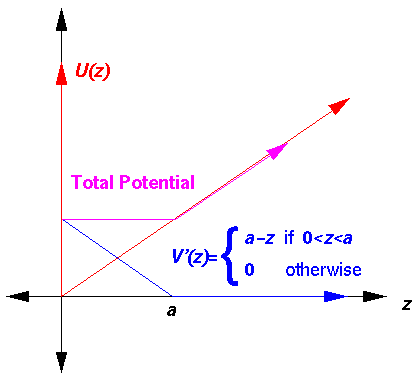
The above total potential
can be "easily" solved. For 0<z'<a
Schrödinger's equation solution is
sin(kz') where k2=E'-a. For z'>a,
we have our usual Airy solutions: Ai(z'-E'). As usual we find eigenenergies
by solving the equation that comes from matching the logarithmic derivatives
 at z'=a.
at z'=a.

The below plot shows how the energy levels for n=1,2 change as a function of a. Note that perturbation theory tracks the exact result until about a=1.5 for n=1 and a=3.5 for n=2. Note that in both cases the perturbation theory result is a bit above the exact result.
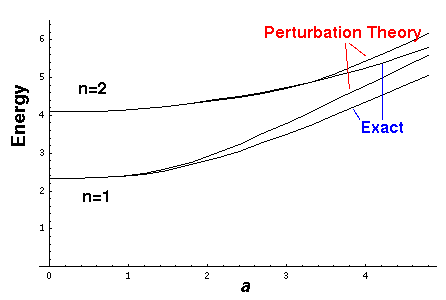
- Pick some value of n and plot how perturbation theory tracks the exact result.
- For any problem we are guaranteed that the perturbation theory result for the ground state lies above the exact result. Why?
- Second order perturbation requires an infinite sum of numerical integrals, and is therefore hard to calculate completely. Calculate the second order correction for a=2 and n=1 including terms through n=10. Compare to the exact result.
Dc f(x) = f(x+c)
- Show that Dc is a linear operator.
- Find the inverse of Dc. Find the Hermitian conjugate of Dc. Is Dc Hermitian? Unitary? etc.
- Show that
Dc f(x) = exp(i pc/
 ) f(x)
) f(x)
where p is the momentum operator, is Taylor's expansion. Using this equation, find the Hermitian conjugate of Dc.
- Carefully show that Dc commutes with the derivative operator d/dx (and hence [Dc, p] = 0).
- Consider the 1-d Hamiltonian H for the
linear potential U=z for all z, even z<0.
Show:
[H,Dc] = -c Dc
Use this relationship to show that if
 is an
energy eigenfunction with energy E, then Dc
is an
energy eigenfunction with energy E, then Dc is an energy eigenfunction with energy E-c.
(This problem is important in the usual treatment of raising and lowering operators in SHM.
See any QM textbook -- my treatment on SHM p.8 is intensionally unusual.)
is an energy eigenfunction with energy E-c.
(This problem is important in the usual treatment of raising and lowering operators in SHM.
See any QM textbook -- my treatment on SHM p.8 is intensionally unusual.)
- Show that state Dc
 is normalized if
is normalized if
 is normalized. (In the usual treatment of lowering operators
one finds that repeatedly lowering a state must eventually produce a zero-normed
state.)
is normalized. (In the usual treatment of lowering operators
one finds that repeatedly lowering a state must eventually produce a zero-normed
state.)
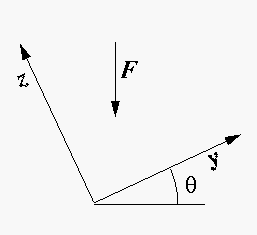
- Solve Schrödinger's equation in this case, reporting the eigenenergies
and wavefunctions in terms of the normal (dimensioned!) variables
(like y, z, Fy, Fz,
m,
 ).
).
- Write down the ground state energy as a function of
 for fixed |F|.
for fixed |F|.
- Since we observe energy differences as emitted photon energies, energy
differences are in some sense more fundamental than energies.
Plot both the ground state energy and the first excited energy
as a function of
 so you can see how the energy difference
depends on
so you can see how the energy difference
depends on  .
.
- Consider the cases
 =45° and 30°. Calculate
the energies of the lowest 8 eigenstates. Plot the results.
=45° and 30°. Calculate
the energies of the lowest 8 eigenstates. Plot the results.
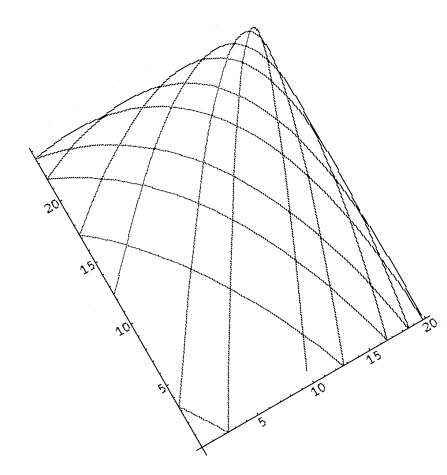
For comparison, the above is an example of the Newtonian trajectory for this potential...follow the bouncing ball!
 . Consider the effect of a small
change in
. Consider the effect of a small
change in  in first order perturbation theory, i.e.,
in first order perturbation theory, i.e.,
U = cos z + sin
z + sin y
y
U' = (-sin z + cos
z + cos y)
y)


Compare the results of perturbation theory to the exact result.
 is the standard deviation of the
wavefunction:
is the standard deviation of the
wavefunction:
 = N exp(-y'2/4
= N exp(-y'2/4 2)
exp(i k0y')
2)
exp(i k0y')
What is the mean position? Find the mean momentum of this wavefunction and the standard deviation of the momentum. What is the value of the Heisenberg Uncertainty product in this case?

Prove this. Show also that the final "quantum cannon" wavefunction is a linear combination of terms like the above and hence also a solution to the time dependent Schrödinger's equation.
I claim that this kind of messysolves our time-dependent Schrödinger's equation. This task is left for a problem.
where the reference is to the force-free motion in in the y direction of the 2d fall, which was derived as follows:
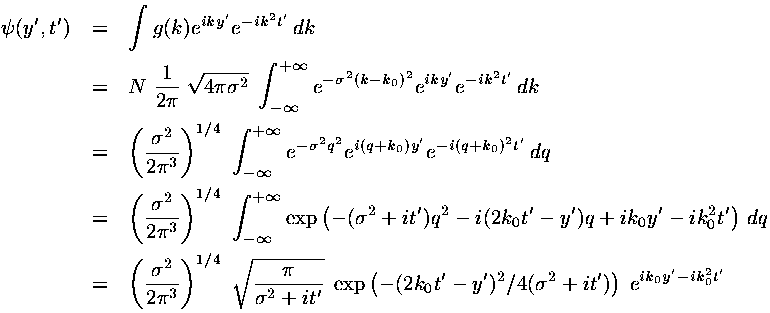
Starting with the last formula, show directly (perhaps using Mathematica)
that this  is a solution to the time-dependent Schrödinger's equation.
is a solution to the time-dependent Schrödinger's equation.

Use these plots to calculate the phase and group velocity displayed in this packet.
z(t)=z0+v0t+½at2
Compare the fit parameters to those expected from the construction of the wave-packet.
